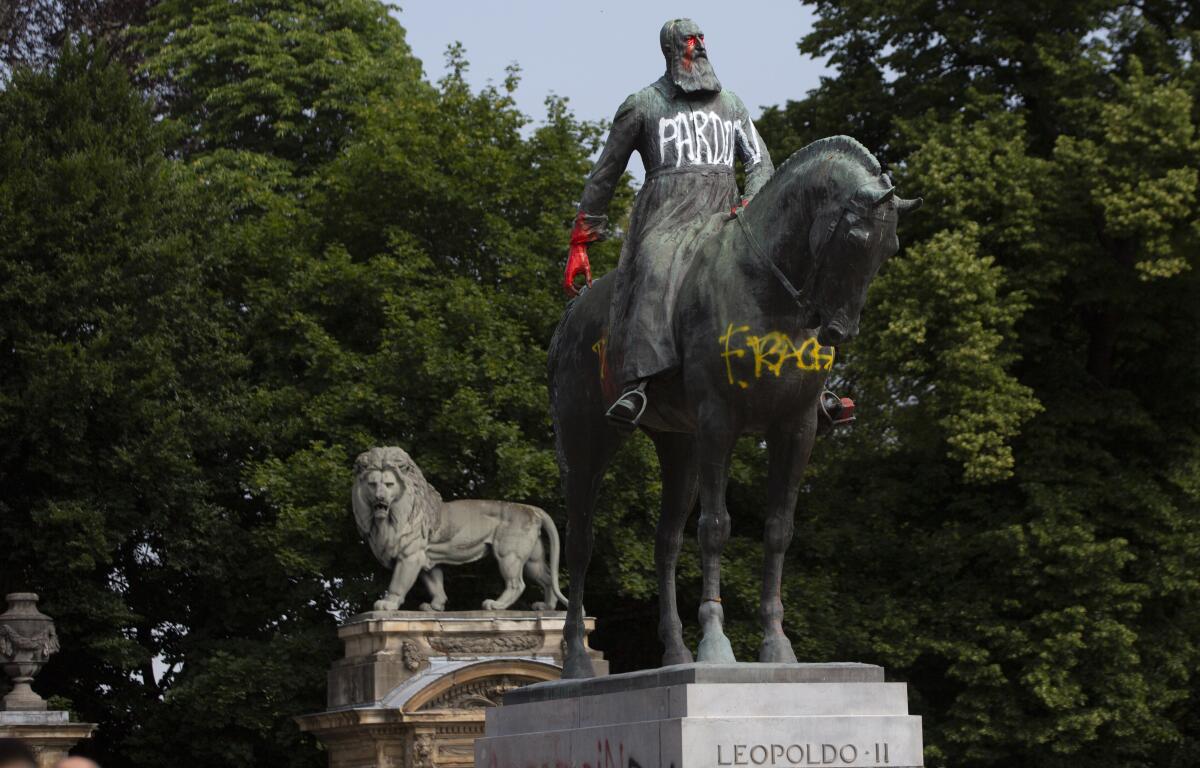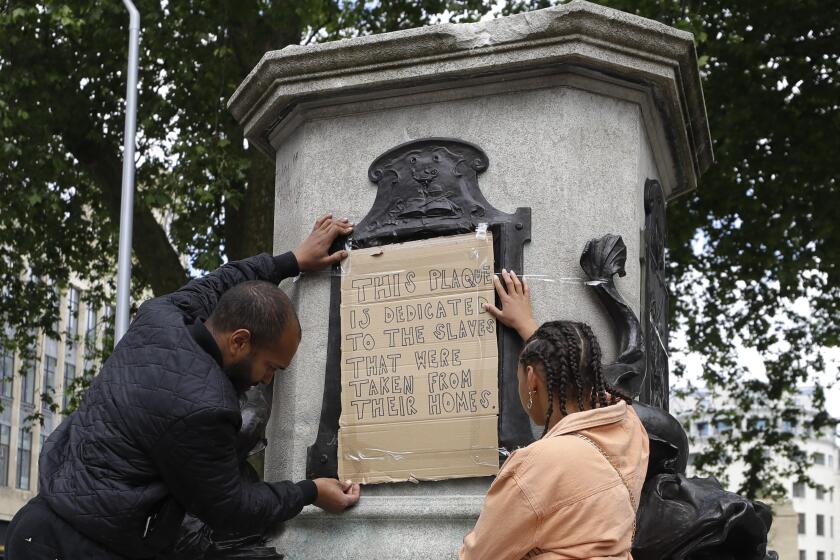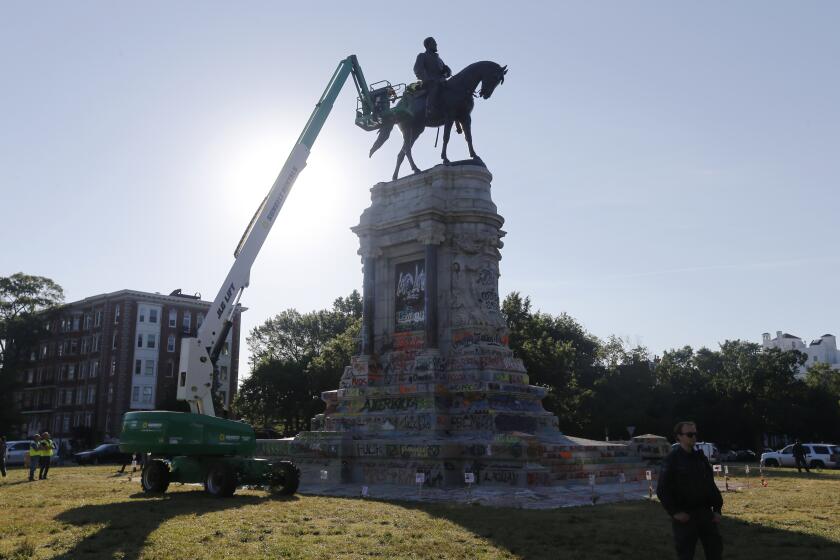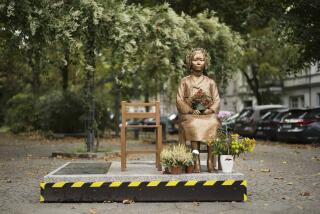Belgium’s colonial-era King Leopold faces reckoning as anti-racism protests grow

- Share via
TERVUREN, Belgium — When it comes to ruthless colonialism and racism, few historical figures are more notorious than Leopold II, the Belgian king who held Congo as his personal property and may have been responsible for the deaths of millions of Congolese more than a century ago.
Yet across Belgium, the monarch’s name is still found on streets and tunnels. Cities are dotted with his statues and busts, even as evidence of his misdeeds has piled up over the decades.
Now a reckoning seems to be at hand.
The protests sweeping the world after George Floyd’s death in the U.S. have added fuel to a movement to confront Europe’s role in the slave trade and its colonial past. Leopold is increasingly seen as a stain on the nation over which he reigned from 1865 to 1909. Demonstrators want him removed from public view.
In just the last week, a long-running trickle of dissent that resulted in little more than occasional vandalism has turned into a torrent, with statues of Leopold defaced in a half-dozen cities. In the port town of Antwerp, where much of the Congolese rubber, minerals and other natural riches entered the nation, one statue was burned and had to be removed for repairs. It is unclear whether it will ever come back.
“When you erect a statue, it lauds the actions of who is represented. The Germans would not get it into their head to erect statues of Hitler and cheer them,” said Mireille-Tsheusi Robert, president of the Congolese action group Bamko-Cran, which wants all Leopold statues removed from Belgian cities. “For us, Leopold has committed a genocide.”
London’s mayor says statues of imperialist figures could be removed from the city’s streets after a statue of a slave trader was toppled in Bristol.
On Wednesday, an internet petition to rid the capital, Brussels, of all Leopold statues swept past 70,000 signatures. Also this week, regional education authorities promised history curriculum reforms to better explain the true character of colonialism. And at the University of Mons in southern Belgium, authorities removed a bust of the king, saying they wanted to make sure “nobody could be offended by its presence.”
Similar efforts are unfolding in Britain, where at least two statues of prominent figures connected to the slave trade have been taken down by protesters or city officials. London’s mayor has promised a review of all monuments. In the U.S., protesters tore down a statue of Confederate President Jefferson Davis along famed Monument Avenue in Richmond, Va., on Wednesday night. The death of Floyd has prompted similar Confederate monument removals around the nation.
In Kinshasa, Congo’s capital, a replica of the main Leopold statue in Brussels had already been relegated to a museum park ages ago. The equestrian bronze was first erected in 1928, but seven years after independence from Belgium in 1960, it was ordered taken down by then dictator Mobutu Sese Seko.
In 2005, authorities put it back up, intending it to serve as a reminder of the horrors of colonial rule — with an updated plaque. Only a day later, though, it was removed following a public outcry. For the last decade, it has sat in a park of colonial monuments.
A judge in Richmond has issued an injunction preventing Virginia Gov. Ralph Northam from removing a statue of Confederate Gen. Robert E. Lee.
Leopold ruled Congo as a fiefdom, forcing many of its people into slavery to extract resources for his personal profit. His early rule, starting in 1885, was famous for its brutality, which some experts say left as many as 10 million dead.
After his ownership of Congo ended in 1908, he handed the central African country over to the Belgian state, which continued to hold sway over an area 75 times its size until the nation became independent in 1960.
Leopold has come to symbolize the racism and inequality citizens of Congolese descent have had to endure. Next to the royal palace stands an equestrian statue with Leopold gazing solemnly toward the horizon. On Wednesday, his hands and eyes were covered with red paint, and expletives were spray-painted on the side of the monument.
Maximilian Christiaens, an architect with a Congolese mother and Belgian father, who came to see the statue after the defacing, realizes the issue is part of his identity. Since Congo achieved independence, Belgium’s Congolese population has swelled to about 230,000 in a nation of 11 million.
“You know, we feel at home here, but seeing symbols like this in the city and all over the country gives us the opposite signal,” Christiaens said. He would like to see them torn down.
Controversy over Belgium’s renovated Royal Museum for Central Africa is in some ways akin to the debate in the United States over Civil War memorials.
A similar struggle is playing out in the majestic woods east of Brussels in Tervuren, where the palatial Royal Museum for Central Africa stands. It was built over a century ago to glorify Leopold’s colonial exploits and to convince Belgians that their country was delivering civilization to the heart of wild Africa.
Museum director Guido Gryseels fully understands the challenges and the sensitivities, especially after a Leopold statue was defaced in the gardens outside the museum last week. He has sought to shift the museum’s views on colonialism into a contemporary reassessment of a flawed past. This week, the Black Lives Matter logo was displayed on digital screens at the museum entrance.
As part of a major renovation he oversaw, Gryseels consigned the racist statues of Congolese and the glorifying busts of the Belgian military to the “depot” of outdated sculptures in the museum’s cellars.
“We wanted to keep them somewhere so that the visitors could still see, so that we could explain: ‘This is how we looked at Africa before,’” Gryseels said.
Upstairs, in the grand rooms, the only bust of Leopold on display is made of ivory and aims to explain how the plunder of Congo extended to the wholesale slaughter of elephants.
Breaking News
Get breaking news, investigations, analysis and more signature journalism from the Los Angeles Times in your inbox.
You may occasionally receive promotional content from the Los Angeles Times.
Because the museum is a listed architectural treasure, Leopold’s royal double-L monogram remains plastered all over the building. But Congolese artists have been asked to make a counterpoint, and in the main hall now stands a sculpture of the skull of a Congolese chief who was beheaded by a Belgian. In front of statues that could not be moved because they were protected, there are now transparent drapes with images criticizing Belgian actions in Congo.
“It would have been impossible 30 years ago, but there is a step forward,” Robert said. Still, she said the changes do not go far enough and the museum needs to better embrace Congolese in its management structure.
Just about everybody acknowledges that Belgian society needs to take a hard look at its past. The Catholic Church, the dominant force in education during much of Belgium’s existence, was at worst an active participant in colonialism, at best a passive bystander. And since many Belgians had family members who went to Congo to seek their fortunes, there is a sense of unease in confronting the history of racism and exploitation.
“The amnesia is linked to the money the Belgians made in Congo,” Robert said.
For many years, Belgian colonial authorities peddled the idea that the king went to Congo to stop the slave trade, Gryseels said, when it was really “a pretext to make big economic gains.”
More to Read
Sign up for Essential California
The most important California stories and recommendations in your inbox every morning.
You may occasionally receive promotional content from the Los Angeles Times.













